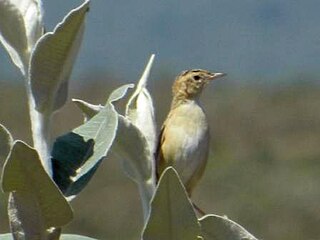
The African palm swift is a small swift. It is very similar to the Asian palm swift, Cypsiurus balasiensis, and was formerly considered to be the same species. The Malagasy palm swift was also recently split from this species. This is a common species with a very wide distribution which faces no obvious threats and may be increasing in numbers as a result of the cultivation of the exotic Washington palm, so the International Union for Conservation of Nature has rated its conservation status as being of "least concern".

The Asian palm swift is a small swift. It is very similar to the African palm swift, Cypsiurus parvus, and was formerly considered to be the same species.

The green-backed camaroptera, also known as the bleating camaroptera, is a small bird in the family Cisticolidae. This bird is a resident breeder in Africa south of the Sahara Desert. Recent studies suggest this species and the grey-backed camaroptera may be the same species.

The bird genus Apus comprise some of the Old World members of the family Apodidae, commonly known as swifts.

The mistletoe tyrannulet is a very small bird, a passerine in family Tyrannidae, the tyrant flycatchers.

The African black swift, also known as the African swift or black swift, is a medium-sized bird in the swift family. It breeds in Africa discontinuously from Liberia, Cameroon, Zaire, Uganda and Kenya southwards to South Africa. The "black swifts" of Madagascar and the Comoros are either taken as two subspecies of the African black swift, or otherwise deemed a full species, the Malagasy black swift.

The neddicky, or piping cisticola, is a small passerine bird in the family Cisticolidae, which is native to Africa, southwards of the equator. Its strongholds are the light woodlands and shrublands of the subtropics and temperate regions of southern Africa. The common name, neddicky, is the Afrikaans name for the species.

Fodies are small passerine birds belonging to the genus Foudia in the weaver family Ploceidae.

The scarce swift is a species of swift in the family Apodidae. It has a disjunct range of presence throughout the Afromontane : Cameroon line, Albertine Rift montane forests, Kenya, Tanzania, Malawi and Mozambique.
The dusky long-tailed cuckoo is a species of cuckoo in the family Cuculidae. It is found in forests in Central Africa. The IUCN has assessed it as a least-concern species.

The Malagasy kingfisher or Madagascar kingfisher is a species of bird in the family Alcedinidae that is found in Madagascar, Mayotte and the Comoros. Its natural habitat is subtropical or tropical mangrove forests.

The black-backed cisticola or black-necked cisticola is a species of passerine bird in the family Cisticolidae. It is found in Burkina Faso, Chad, Republic of the Congo, Democratic Republic of the Congo, Ivory Coast, Eritrea, Ethiopia, Ghana, Guinea, Guinea-Bissau, Kenya, Mali, Nigeria, Senegal, Sierra Leone, South Sudan, Tanzania, Togo, and Uganda. Its natural habitats are subtropical or tropical dry lowland grassland and subtropical or tropical seasonally wet or flooded lowland grassland.

The black-tailed cisticola is a species of bird in the family Cisticolidae found in Angola and Democratic Republic of the Congo. Its natural habitat is dry savanna and canopy of smaller trees. It forages for insects both in the canopy and on the ground.

The nelicourvi weaver is a species of bird in the family Ploceidae. It is endemic to Madagascar. Together with its closest relative, the sakalava weaver, it is sometimes placed in a separate genus Nelicurvius. A slender, sparrow-like bird, it is 15 cm (5.9 in) long and weighing 20–28 g (0.71–0.99 oz). Breeding males have a black bill and head, brown eyes, yellow collar, grey belly, chestnut-brown lower tail coverts, olive back, and blackish flight feathers edged greenish. Non-breeding males have mottled grey and green heads. In the breeding female the front of the head is yellow and the back olive green, with a broad yellow eyebrow. It builds solitary, roofed, retort-shaped nests, hanging by a rope from a branch, vine or bamboo stem, in an open space. It primarily feeds on insects, looking on its own or in very small groups, often together with long-billed bernieria. Its natural habitat is subtropical or tropical moist lowland and mountain forests. The conservation status of Nelicourvi weaver is least concern according to the IUCN Red List.

The Sakalava weaver sometimes known as the Sakalava fody is a species of bird in the family Ploceidae. It is endemic to Madagascar. The bird is 15 cm (5.9 in) long and weighs 20–28 g (0.71–0.99 oz).

Cypsiurus is a genus of the swift family of birds.

Syed Abdulla Hussain was an Indian ornithologist. He is best known for the work he undertook at the Bombay Natural History Society (BNHS) along with Salim Ali. A species of frog Nyctibatrachus hussaini from Kudremukh near his home, was named after him but the species name later became embroiled in controversy.

Empisini Nature Reserve was established in 1973 and is situated in Umkomaas, KwaZulu-Natal, South Africa. The reserve is approximately 60 ha in extent and is owned by the borough of uMkhomanzi which has been incorporated into the eThekwini municipality. Empisini is managed jointly by eThekwini and the Umkomaas centre of the Wildlife and Environment Society of South Africa. Empisini takes its name from a perennial stream which flows through it, and means "Place of the Hyena" in isiZulu. The reserve consists of coastal forest, wetlands, grassy slopes and a dam. Infrastructure consists of hiking trails, demarcated picnic sites, overnight cabins, and a tree house.

The Apodinae are a subfamily of swifts and contain the following species:

















